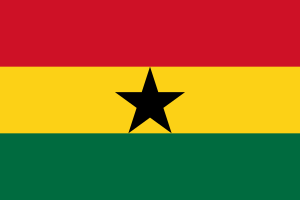Flag of Ghana
| Year dem found am | 1957 |
|---|---|
| Dey apply to jurisdiction | Ghana |
| Genre | horizontal triband, Pan-African flag |
| Aspect ratio (W:H) | 3:2 |
| Color | red, gold, green, black |
| Depicts | field, five-pointed star |
| Design by | Theodosia Okoh |
| Date dem dissolve, abolish anaa demolish | 1964 |
| Unicode character | 🇬🇭 |
De national flag of Ghana dey consist of horizontal triband of red, yellow, den green. Na dem design am in replacement of de British Gold Coast ein Blue Ensign.[1]
Na dem adopt de flag upon de independence of de Dominion of Ghana for March 6, 1957. Na Theodosia Okoh, renowned Ghanaian artist design am de same year.[2][3][4][5] Na dem fly de flag til 1964 wey dem then reinstate am insyd 1966. De flag of Ghana dey consist of de Ethiopian Pan-African colours of red, yellow, den green insyd horizontal stripes plus black five-pointed star insyd de centre of de gold stripe. Na de Ghanaian flag be de second African flag afta de flag of de Ethiopian Empire make e feature dese colours, although de colours be inverted. De design of de Ghanaian flag influence de designs of de flags of Guinea-Bissau (1973) den São Tomé and Príncipe (1975).
History
[edit | edit source]-
Flag of de Gold Coast, de forerunner to Ghana. Dem use til 1957.
-
First flag of de Union of African States plus Guinea, dem use between 1958 den 1961.
-
Second flag of de Union of African States, dem use between 1961 den 1963 (after Mali join).
-
Ghana national flag (1964–66).
-
Flag of de Presidency of Ghana since 1966. Presidential Standard of Ghana; replicate of de national flag of Ghana plus gold rim.
-
House flag of Ghana ein former national shipping carrier, de Black Star Line
De Ghanaian government flag, dem adopt insyd 1957, na dem fly am til 1962. Similarly, wen de country form de Union of African States, na dem model de flag of de Union for Bolivia ein flag top, buh plus two black stars, wey dey represent de nations. Insyd May 1959, dem add third star.[6]
Similar flags by design
[edit | edit source]References
[edit | edit source]- ↑ "Flag sequence (flag, FLAG, FLAG tag)", The Dictionary of Genomics, Transcriptomics and Proteomics, Weinheim, Germany: Wiley-VCH Verlag GmbH & Co. KGaA, p. 1, 2015-12-18, doi:10.1002/9783527678679.dg04454, ISBN 978-3-527-67867-9
- ↑ "Mrs. Theodosia Salome Okoh". GhanaWeb. Retrieved 2020-08-19.
- ↑ Celebs, African (2018-03-06). "Mrs Theodosia Okoh: The Woman Who Designed The Ghanaian Flag – African Celebs". Retrieved 2024-03-28.
- ↑ Rich, Jeremy (2011-12-08), "Okoh, Theodosia Salome", African American Studies Center, Oxford University Press, doi:10.1093/acref/9780195301731.013.49700, ISBN 978-0-19-530173-1
- ↑ Aikins, Ama de-Graft; Koram, Kwadwo (2017-02-16), "Health and Healthcare in Ghana, 1957–2017", The Economy of Ghana Sixty Years after Independence, Oxford University Press, pp. 365–384, doi:10.1093/acprof:oso/9780198753438.003.0022, ISBN 978-0-19-875343-8
- ↑ "The New Union Flag Project", Bad English, Manchester University Press, 2020-07-28, doi:10.7765/9781526108852.00005, ISBN 978-1-5261-0885-2











